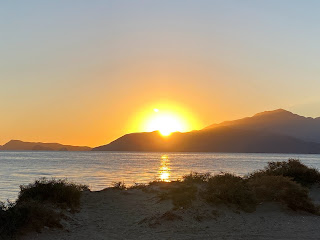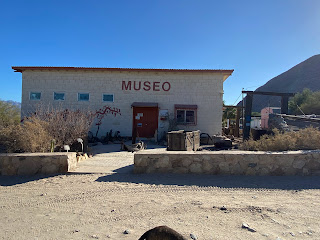Bahia De Los Angeles 12.12.21
This Sunday morning at Bahia de Los Angeles the sun rose streaming through the clouds. The weather though cooler than we enjoyed on other beaches, warmed enough so we could bring out shorts out again. Today we had no wind. In the early morning about 5:30 am, Liz, Bill, Kirk and Euclid left to go fishing in a panga rented from Daggett’s Camp. A guide went with them. This was something they all had looked forward to doing. They had to ride in the boat on the boat trailer to the launch at the end of town at least 3 miles away. The rest of us except Ruth who stayed back to do a day of trailer cleaning as crossing the border is now only 5 days away. The rest of us left for town at various times during the morning to go to the little Museo which was only open from 10-1pm.
We watched this sunrise through our front door as we ended up being the trailer closest to the beach. It was a great way to enjoy coffee and welcome a warmer day.This guy was our official welcoming committee for the museum. He was very curious about what we were doing and may have hoped we carried treats.
The museum for it’s size contained several well curated areas. There was a good display of various fish and shell fish that inhabit the Bahia. We were able to identify some unusual shells we had seen on the beach and confirmed that we had, indeed, found a fossilized shellfish. This area has such a large array of types of fish from very large to some of the smallest. The shellfish abound also with a rich variety. Steinbeck in his Notes from the Sea of Cortez the rich diversity they saw as they collected specimens in the 40’s. There was also a display representing native American people who inhabited this area prior to discovery of this area by the Europeans. There is on group that survived and continues to thrive here. Though they have had to incorporate some parts of other cultures they continue to teach their language and their arts to their children. I apologize for not giving you their name. The early vaqueros also had to display with pictures, clothing and the leather protective gear they made and wore to keep safe from the brush and cacti. Horse and burro tack, including pack saddles were in evidence. Mining in the area was demonstrated with articles and mining equipment. One silver mine, as it began, required that the unprocessed ore be packed out 40 miles by burro and water packed in the same distance. These mines were mostly closed in the 50s. Even though, by that time, the methods and equipment had improved. At one time, a small rail engine replaced the pack burros and it become more efficient. At current prices, though the mines still contain silver ore, no one has thought it is worth the investment to reopen. American volunteers run and maintain the museum. The woman there was quite helpful.
Lunch on the patio of a restaurant that sported many Bahia Racer stickers. An indication that many of them frequent this place during and after the races. Who needs a Michelin rating when you have that one.Though the town of LBA as it is called is not known for its restaurants in town, several of us gave it a try. Jim and I, as well as Paul and Kristina went to one on the edge of town which looked, due to all the stickers, like one frequented by the Baja Racers. It had a sign on the door in English and Spanish which read No Ice Chests, Food or Drinks inside. As well as T-shirt required. We sat on the outside porch for lunch and were joined by files and a big neighbor dog, a husky. Paul and Kristina made a good choice by going inside not joined by flies or stray dogs. The food we decided was OK. We have been spoiled by the excellent meals on this trip.
This husky joined us on the patio during lunch. When he did not score any carne asada, he gave us his tail and went off to better hunting.
Much later than we had expected about 4:00 pm, our fisher people returned with a good catch of a very large grouper, yellowfin tuna and some smaller fish. The guide cleaned them at a table at Daggett’s Camp. The inedible parts were tossed near the water to be eaten by many vultures, gulls and ravens. The water edge was littered later with the remaining bones which were taken out to sea by the tide during the night. The is a restaurant and hotel about a mile down the road from us who will prepare and cook the fish for you for $10 a person. The chef was given our applause at the end of the meal. The dishes he prepared and the display on the table was beautiful. Our thanks to him and the fisher people in our group.
This was the beautifully prepared grouper. It was so good and we profusely thanked the chef and the fisher people. The rest of the catch including the yellow fin tuna were included on one of two trays. Their was also a sashimi of the fish also. We had 5 trays of this size and presentation.A side light of the fishing trip, we learned later was that they should have been back by 1:00 pm but the battery on the motor died. They were adrift for over two hours waiting for another boat to bring them another battery to get started again. The swells were high at times and they were thankful to the guide who stayed on radio to get them help and do his best to keep the boat headed the right way with no motor. We learned more the next morning.










Comments
Post a Comment